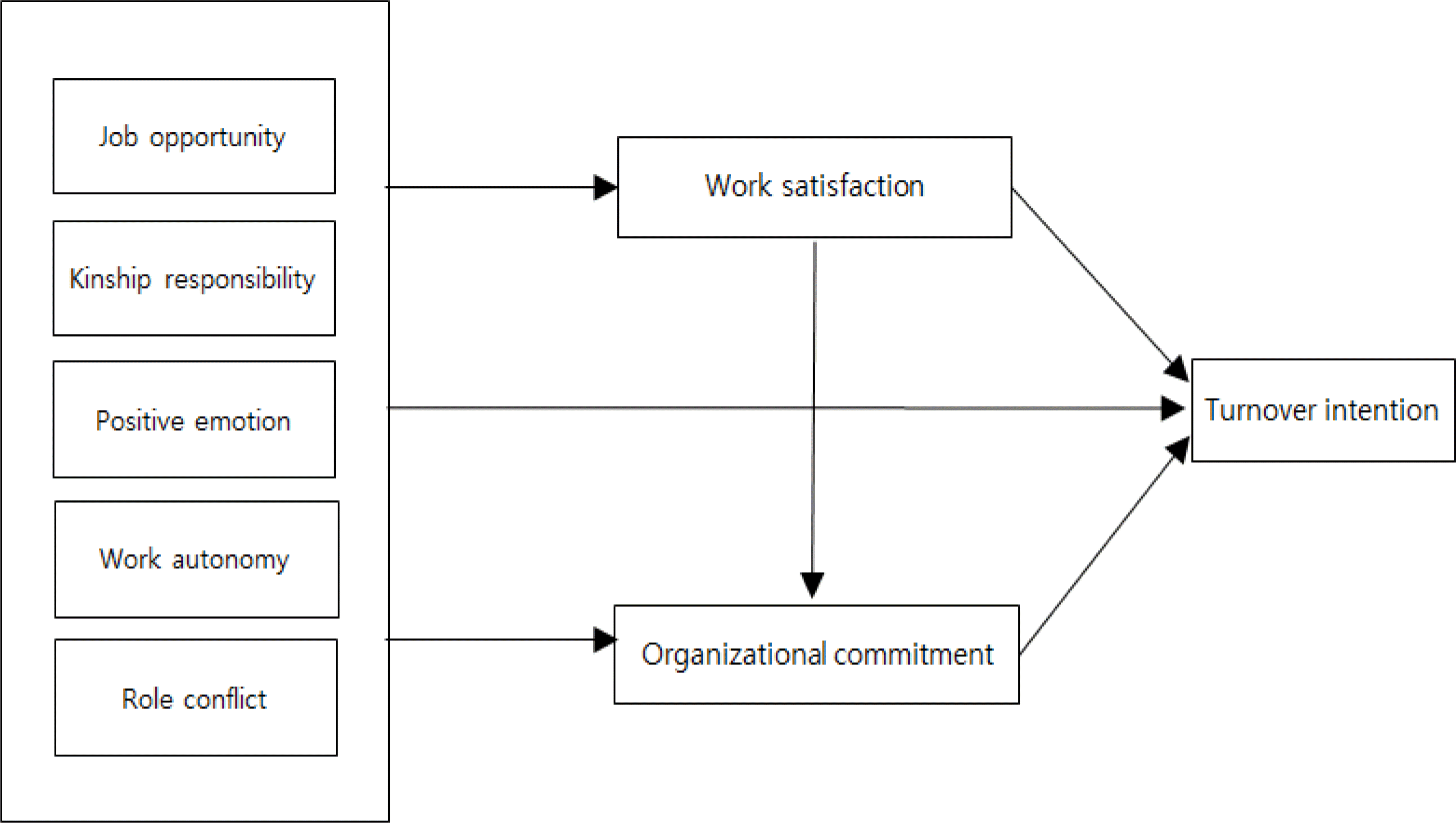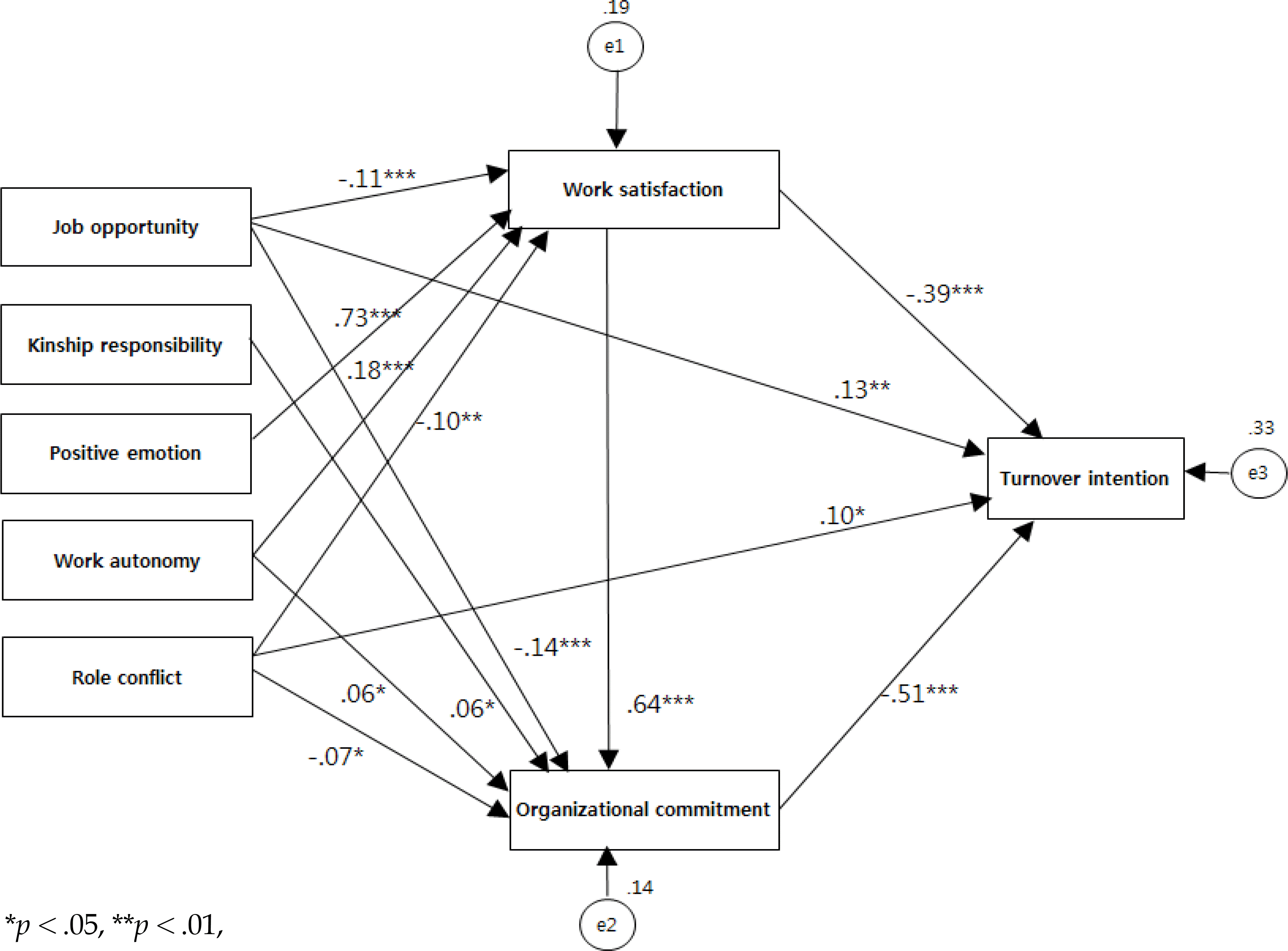Abstract
Purpose
The purpose of this study was to develop and test a predictive model on the male nurses’ turnover intention.
Methods
This study utilized the model-testing design based on the Price's causal model of turnover. This study collected data from 306 male nurses on a national scale with structured questionnaires measuring job opportunity, kinship responsibility, positive emotion, work autonomy, role conflict, work satisfaction, organizational commitment, and turnover intention. The data were analyzed using SPSS/WIN 22.0 program and AMOS 20.0 program.
Results
As the outcomes satisfied the recommended level, the hypothetical model appeared to fit the data. Twenty-seven of the 38 hypotheses selected for the hypothetical model were statistically significant. 54.2% of turnover intention was explained by job opportunity, kinship responsibility, positive emotion, work autonomy, role conflict, work satisfaction and organizational commitment.
REFERENCES
1.Al-hussami M., Darawad M., Saleh A., Hayajneh F. Predicting nurses'turnover intentions by demographic characteristics, perception of health, quality of work, and work attitudes. International Journal of Nursing Practice. 2013. 20:79–88. http://dx.doi.org/10.1111/ijn.12124.
2.Cimotti JP., Aiken LH., Sloane DM., Wu ES. Nursing staffing, burnout, and health care-associated infection. American Journal of Infection Control. 2012. 40:486–90. http://dx.doi.org/10.1016/j.ajic.2012.02.029.
3.Spetz J., Harless DW., Herrera CN., Mark BA. Using minimum nurse staffing regulations to measure the relationship between nursing and hospital quality of care. Medical Care Research and Review. 2013. 70(4):380–99. http://dx.doi.org/10.1177/1077558713475715.

4.Sawatzky JA., Enns CL. Exploring the key predictors of retention in emergency nurses. Journal of Nursing Management. 2012. 20(5):696–707. http://dx.doi.org/10.1111/j.1365-2834.2012.01355.x.

5.Kim SH. Nurse state exam pass ‘man's one thousand people'. The Korean Nurses Association News. 2013 March 5. Sect. 01.
6.Kim MY. An Exploratory Study of Masculinity in Nursing. Journal of Korean Clinical nursing research. 2009. 15(2):37–46.
7.Son HM., Koh MH., Kim CM., Moon JH., Yi MS. The male nurses' experiences of adaptation in clinical setting. Journal of Korean academy of nursing. 2003. 33(1):17–25.

8.Chen SH., Yu HY., Hsu HY., Lin FC., Lou JH. Organisational support, organisational identification and organisational citizenship behaviour among male nurses. Journal of Nursing Management. 2013. 21:1072–82. http://dx.doi.org/10.1111/j.1365-2834.2012.01449.x.

9.Almalki MJ., FitzGerald G., Clark M. The relationship between quality of work life and turnover intention of primary health care nurses in Saudi Arabia. Human Resources for Health. 2012. 12(1):314–24. http://dx.doi.org/10.1186/1472-6963-12-314.

10.Rowlinson L. Lived experience of being a nurse from a male and female perspective. British Journal of Nursing. 2013. 22(4):218–22.

11.McMillian J., Morgan SA., Ament P. Acceptance of male registered nurses by female registered nurses. Journal of Nursing Scholarship. 2006. 38(1):100–6.

12.Lee KJ., Kim MY. The relationship of gender role conflict and job satisfaction upon organizational commitment in male nurses. Korean Journal of Adult Nursing. 2014. 26(1):46–57. http://dx.doi.org/10.7475/kjan.2014.26.1.46.

13.Ahn MK., Lee MH., Kim HK., Jeong SH. Job satisfaction, organizational commitment and turnover intention among male nurses. Journal of Korean academy of nursing administration. 2015. 21(2):203–11. http://dx.doi.org/10.11111/jkana.2015.21.2.203.

14.Price JL. Reflections on the determinants of voluntary turnover. International Journal of Manpower. 2001. 22(7):600–24.

15.Price JL., Mueller CW. A causal model of turnover for nurses. Academy of Management Journal. 1981. 34:543–65.

16.Kim SW., Price JL., Mueller CW., Watson TW. The determinants of career intent among physicians at a U.S. air force hospital. Human Relations. 1996. 49(7):947–76.

17.Lee TH. An empirical study on the determinants of turnover intention of geriatric care helpers: focusing on the mediating effects of job satisfaction and organizational commitment. [dissertation]. Seoul: Hansung University;2013. p. 1–206.
18.Watson D., Clark LA., Tellegram A. Development and validation of brief measures of positive and negative affect: the PANAS scales. Journal of Personality and Social Psychology. 1988. 54:1063–70.

20.Rizzo JR., House RJ., Lirtzman SI. Role conflict and ambiguity in complex organizations. Administrative Science Quarterly. 1970. 15(2):150–63.

21.Brayfield AH., Rothe H. An index of job satisfaction. Journal of Applied Psychology. 1951. 35(5):1173–82.

22.Mowday RT., Steers RM., Porter LW. The measurement of organizational commitment. Journal of Vocation Behavior. 1979. 14(2):224–47.

23.O'Brien-pallas L., Murphy GT., Shamiran J., Li X., Hayes LJ. Impact and determinants of nurse turnover: a pan-Canadian study. Journal of Nursing Management. 2010. 18(8):1073–86. http://dx.doi.org/10.1111/j.1365-2834.2010.01167.x.
24.Lee EH., Cho KS., Son HM., Yi YJ., Yoo CS. Frequency and severity of the nurses'role conflict in the hospital nurses. Journal of Korean Clinical nursing research. 2013. 19(1):81–95.
25.Brooks BA., Storfjell J., Omoike O., Ohlson S., Stemler L., Shaver J, et al. Assessing the quality of nursing work life. Nursing Administration Quarterly. 2007. 31(2):152–7.

26.Ryu YO., Ko E. Influence of emotional labor and nursing professional values on job satisfaction in small and medium-sized hospital nurses. Journal of Korean Academy of Fundamentals of Nursing. 2015. 22(1):7–15. http://dx.doi.org/10.7739/jkafn.2015.22.1.7.

27.Clow KA., Ricciardelli R., Bartfay WJ. Attitudes and stereotypes of male and female nurses: The influence of social roles and ambivalent sexism. Canadian Journal of Behavioural Science. 2014. 46(3):446–55.

28.Price JL., Mueller CW. Absenteeism and turnover of hospital employees. Greenwich, CT: JAI Press.;;1986.
29.Downing SM. Reliability: on the reproducibility of assessment data. Medical Education. 2004. 38(9):1006–12.

30.Kath LM., Stichler JF., Ehrhart MG., Schultze TA. Predictors and outcomes of nurse leader job stress experienced by assocoation of women's health members. Journal of Obstetric, Gynecologic, & Neonatal Nursing. 2013. 42(1):12–25. http://dx.doi.org/10.1111/j.1552-6909.2012.01430.x.
Table 1.
Descriptive Statistics of Study Variables (N=306)
Table 2.
Fit Index of the Hypothetical Model
Table 3.
Direct Effect, Indirect Effect, and Total Effect in Hypothetical Model
| Endogenous variables Exogenous variables | SE | CR | p | SMC | Direct effect | p | Indirect effect | p† | Total effect | p† |
|---|---|---|---|---|---|---|---|---|---|---|
| Work satisfaction | .613 | <.001 | -.11 | <.001 | ||||||
| Job opportunity | -.13 | -3.66 | <.001 | -.11 | <.001 | .73 | <.001 | |||
| Positive emotion | .65 | 17.17 | <.001 | .73 | <.001 | .18 | <.001 | |||
| Work autonomy | .19 | 5.25 | <.001 | .18 | .005 | -.10 | .005 | |||
| Role conflict | -.10 | -2.85 | .005 | -.10 | ||||||
| Organizational commitment | .643 | |||||||||
| Job opportunity | -.17 | -5.07 | <.001 | -.14 | <.001 | -.07 | <.001 | -.21 | <.001 | |
| Kinship responsibility | .08 | 2.50 | .013 | .06 | .013 | .06 | .013 | |||
| Positive emotion | .46 | <.001 | .46 | <.001 | ||||||
| Work autonomy | .07 | 2.06 | .041 | .06 | .041 | .11 | <.001 | .18 | <.001 | |
| Role conflict | -.07 | -2.09 | .038 | -.07 | .038 | -.06 | .005 | -.14 | .001 | |
| Work satisfaction | .69 | 17.63 | <.001 | .64 | <.001 | .64 | <.001 | |||
| Turnover intention | .542 | |||||||||
| Job opportunity | .12 | 2.40 | .003 | .13 | .003 | .15 | <.001 | .29 | <.001 | |
| Kinship responsibility | -.03 | .022 | -.03 | .022 | ||||||
| Positive emotion | -.52 | <.001 | -.52 | <.001 | ||||||
| Work autonomy | -.16 | <.001 | -.16 | <.001 | ||||||
| Role conflict | .08 | 1.99 | .046 | .10 | .046 | .11 | .001 | .21 | <.001 | |
| Work satisfaction | -.33 | -5.20 | <.001 | -.39 | <.001 | -.327 | .001 | -.72 | <.001 | |
| Organizational commitment | -.38 | -6.04 | <.001 | -.51 | <.001 | -.51 | <.001 |




 PDF
PDF ePub
ePub Citation
Citation Print
Print




 XML Download
XML Download